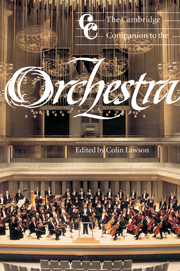Book contents
- Frontmatter
- 1 The history of the orchestra
- 2 The development of musical instruments: national trends and musical implications
- 3 The orchestral repertory
- 4 From notation to sound
- 5 The art of orchestration
- 6 The history of direction and conducting
- 7 International case studies
- 8 The revival of historical instruments
- 9 Recording the orchestra
- 10 Training the orchestral musician
- 11 The life of an orchestral musician
- 12 Historical recordings of orchestras
- 13 The orchestral composer
- 14 Educational programmes
- 15 The future of the orchestra
- Notes
- Appendices
11 - The life of an orchestral musician
Published online by Cambridge University Press: 28 September 2011
- Frontmatter
- 1 The history of the orchestra
- 2 The development of musical instruments: national trends and musical implications
- 3 The orchestral repertory
- 4 From notation to sound
- 5 The art of orchestration
- 6 The history of direction and conducting
- 7 International case studies
- 8 The revival of historical instruments
- 9 Recording the orchestra
- 10 Training the orchestral musician
- 11 The life of an orchestral musician
- 12 Historical recordings of orchestras
- 13 The orchestral composer
- 14 Educational programmes
- 15 The future of the orchestra
- Notes
- Appendices
Summary
Introduction
The life of an orchestral musician can be highly rewarding, challenging and exciting, but is just as likely to be frustrating, exhausting and unfulfilling. Between these two extremes there are many different realities. In order to understand and determine at which end of the spectruma player's life might fall, one must understand not only the individual's particular circumstances and attitude towards his or her position, but also the artistic, financial and political background in which he or she operates. It is also important to appreciate that most people take up music professionally because they have artistic aspirations, whereas their orchestral role is largely that of an artisan. Artistic creativity lies primarily with conductors and soloists, although there is significant creative input from principal players. Many orchestral musicians understand and accept this role and are able to find great fulfilment and enjoyment, as well as camaraderie, in their work. Those who fail to develop creative outlets often find that the inherent tension of an artist working primarily as an artisan leads to frustration and a lack of personal growth and creativity.
The orchestra as a community
An orchestra is a microcosm of society and a cross-section of people from all kinds of social backgrounds, working together in close proximity. As with any social system, there are many ways of organising its internal political structures, a topic that forms part of the discussion in chapter 15 of this book. As noted by Simon Channing in the previous chapter, orchestras have become ever more consultative throughout the second half of the twentieth century, so that the musical director is no longer a dictator, as was often the case in the past.
- Type
- Chapter
- Information
- The Cambridge Companion to the Orchestra , pp. 194 - 202Publisher: Cambridge University PressPrint publication year: 2003
- 2
- Cited by



